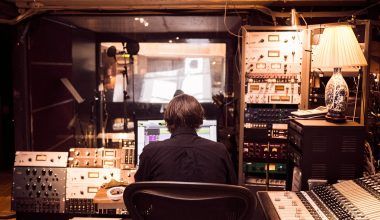When it comes to music production, mastering a song is the cherry on top. It’s the process that takes your finished mix and elevates it into a professional, polished track that’s ready for the world to hear. If you’ve ever wondered how the music you hear on the radio sounds so crisp and balanced, the secret lies in the art of mastering.
In this blog, we’ll dive into the essential steps, tools, and techniques you need to master a song effectively. Whether you’re a beginner or an experienced producer, there’s always something new to learn about this fascinating process.
What Is Mastering and Why Is It Important?
Mastering a song is the final stage of music production. It involves enhancing the overall sound quality of your track, ensuring consistency across all playback systems, and preparing it for distribution. Think of it as the final polish that turns a rough diamond into a sparkling gem.
Without mastering, even the best-mixed song can sound dull or unbalanced. Mastering ensures that your music sounds great no matter where it’s played—whether on headphones, car speakers, or a high-end sound system.
Getting Started: Prepare Your Mix for Mastering
Before diving into the mastering process, you need to make sure your mix is ready. A great master starts with a solid mix. Here are a few tips to ensure your mix is up to par:
- Balance your levels: Make sure all the elements of your track—vocals, instruments, and effects—are balanced.
- Leave headroom: Aim for around -6dB of headroom in your final mix to give the mastering process enough space to work.
- Double-check your EQ: Remove any harsh frequencies and ensure each element has its place in the frequency spectrum.
Preparing your mix properly sets the foundation for mastering a song with precision and clarity.
Tools You’ll Need for Mastering
Mastering doesn’t require a studio filled with expensive gear, but having the right tools makes a big difference. Here are the essentials:
- Digital Audio Workstation (DAW): You’ll need software like Logic Pro, Ableton Live, or Pro Tools to load your track and mastering plugins.
- Mastering plugins: Tools like EQ, compression, limiter, and stereo imaging are crucial for mastering a song effectively. Popular options include iZotope Ozone and FabFilter Pro plugins.
- Reference tracks: Use professional tracks in the same genre as your reference to guide your mastering decisions.
Having these tools at your disposal is the first step toward mastering a song that sounds professional.
Step-by-Step Guide to Mastering a Song
Now that you’re ready, let’s break down the process of mastering a song step by step.
1. Load Your Track into the DAW
Start by importing your mix into your DAW. Make sure the file is in a high-resolution format, such as WAV or AIFF, to preserve sound quality.
2. Apply Equalization (EQ)
EQ is the first tool you’ll use to shape your song’s sound. Begin by addressing any problematic frequencies. For example:
- Low frequencies: Roll off anything below 20 Hz to clean up sub-bass rumble.
- Midrange: Ensure vocals and instruments stand out without clashing.
- High frequencies: Add a touch of sparkle to give your track clarity and air.
Using EQ carefully can enhance the tonal balance and make a big difference in mastering a song.
3. Add Compression for Dynamics
Compression helps control the dynamic range of your track, making it sound consistent and professional. Use a gentle ratio (e.g., 2:1) to tame peaks without squashing the life out of your song.
4. Enhance with Stereo Imaging
Stereo imaging widens your track and creates a sense of space. Push the high frequencies slightly wider while keeping the bass frequencies centered. This step ensures your song sounds great on headphones and large speakers alike.
5. Use Saturation for Warmth
Saturation adds harmonic richness and warmth to your track. Subtle saturation can make a sterile mix sound more vibrant and alive. Be careful not to overdo it; a little goes a long way.
6. Apply Limiting for Loudness
The limiter is the final step in mastering a song. It ensures your track reaches the desired loudness without distortion. Set the ceiling to -0.1 dB to avoid clipping, and slowly raise the gain until your track is competitively loud.
Common Mistakes to Avoid When Mastering a Song
Even seasoned producers can make mistakes during mastering. Here are some pitfalls to watch out for:
- Over-compressing: Too much compression can make your track sound lifeless.
- Excessive loudness: Aim for clarity and balance instead of chasing extreme volume.
- Skipping reference tracks: Comparing your master to professional tracks ensures you’re on the right path.
Avoiding these mistakes will help you master a song that’s both polished and dynamic.
The Role of AI in Mastering
In recent years, AI-powered mastering services like LANDR and eMastered have gained popularity. While these tools offer a quick and affordable solution, they may not always match the quality of a human touch.
AI can be a great starting point, but if you’re serious about mastering a song, consider learning the craft yourself or hiring a professional mastering engineer.
Final Tips for Mastering a Song
- Take breaks: Give your ears time to rest to avoid fatigue.
- Listen on multiple systems: Test your master on headphones, car speakers, and studio monitors.
- Keep learning: Mastering is an art that takes time to perfect. Experiment with different techniques and tools to find what works best for you.
Mastering a song might seem daunting at first, but with patience and practice, it becomes second nature. Whether you’re preparing a track for streaming, radio, or live performance, mastering ensures your music sounds its absolute best.
So, go ahead—grab your favorite track, fire up your DAW, and start mastering! The world is ready to hear your masterpiece.
For further reading, explore these related articles:
- A Guide to Young Singers: Turning Dreams into Reality
- Celebrating Family with Music: The Best Happy Songs About Family
For additional resources on music marketing and distribution, visit DMT Records Pvt. Ltd..






